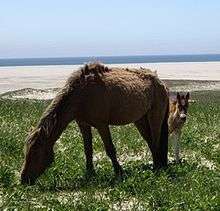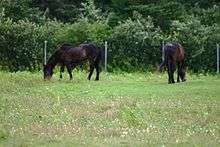Sable Island horse
 Feral Sable Island Horses | |
| Distinguishing features | Small, stocky feral horses |
|---|---|
| Country of origin | Sable Island, Canada |
| Equus ferus caballus | |
The Sable Island Horse, sometimes referred to as the Sable Island Pony, is a type of small feral horse found on Sable Island, an island off the coast of Nova Scotia, Canada. It is a small type, often pony sized, but with a horse phenotype and horse ancestors, and usually dark in color. The first horses were released on the island in the late eighteenth century, and soon became feral. Additional horses were later transported to improve the herd's breeding stock. They were rounded up for private use and sale for slaughter, which by the 1950s had placed them in danger of extinction.
In 1960, the Canadian government protected the horses by law in their feral state. From the 1980s on, long-term, noninvasive herd studies have been performed, and in 2007 a genetic analysis was conducted that concluded the herd was genetically unique enough to interest conservationists. In 2008, the horses were declared the official horse of Nova Scotia, and in 2011, the island was declared the Sable Island National Park Reserve. The herd is unmanaged, and legally protected from interference by humans. The horses live only at Sable Island and at the Shubenacadie Wildlife Park on the mainland of Nova Scotia, with the latter herd descended from horses removed from Sable Island in the 1950s.
Characteristics

The horses that remain on Sable Island are feral. They generally stand between 13 and 14 hands (52 and 56 inches, 132 and 142 cm). Males from the island average about 360 kilograms (790 lb) and females about 300 kilograms (660 lb). The available food on the island limits their size, and the offspring of horses removed from the island and fed more nutritious diets are generally larger. Physically, the horses resemble Spanish horses, with arched necks and sloping croups. Overall, they are stocky and short, with short pasterns that allow them to move easily on sandy or rough ground. Sable Island horses have very shaggy coats, manes and tails, especially during the winter. The tail is full and low-set. Their coats are mostly dark colours, but some do have white markings. About half are bays, with the rest distributed among chestnut, palomino and black.[1][2] Many Sable Island Horses have a natural ambling gait. Prior to their protection, when they could be kept for the use of humans, the horses were known for their sure-footedness and gaits.[3]
The Sable Island horses are a feral horse population that is entirely unmanaged: they are not subject to any kind of interference. Observational research, which is considered noninvasive to the herd, has been conducted by various entities over several decades. The population in recent years (2009 and onward) has varied between 400 and 550 animals.[4] Due to the lack of predators, older horses often die of starvation after their teeth are worn down by a lifetime of exposure to sand and marram, a tough grass. A lack of nutritional food on the island limits the horses' size, and the offspring of those removed from the island and raised on better diets are significantly larger.[2]
History
Sable Island is a narrow, crescent-shaped island located approximately 300 kilometres (190 mi) southeast of Nova Scotia. It is 42 kilometres (26 mi) long and covered in sand dunes and grasses. Over 350 bird species and 190 plant species are found on the island, in addition to the herd of feral horses, which are the most well-known inhabitants.[5]

Although popular legends claim that Sable Island horses swam ashore from the island's many shipwrecks,[6] or were introduced by 16th-century Portuguese explorers,[2] this is not supported by historical or genetic evidence.[7] In reality, the horses were deliberately introduced to the island during the 18th century. The first recorded horses were brought by a Boston clergyman, the Reverend Andrew Le Mercier, in 1737 but most were stolen by passing mariners. The present-day horses are thought by most historians and scientists to have descended mostly from horses seized by the British from the Acadians during the Expulsion of the Acadians.[8] The Acadian horses were descendents of several shipments of French horses, including members of the Breton, Andalusian and Norman breeds, later crossed with horses from New England, including Spanish Barbs.[2] The Boston merchant and shipowner Thomas Hancock purchased some Acadian horses and transported them to Sable Island in 1760, where they grazed the island as pasture.[8] Although often referred to as ponies due to their small size, they have a horse phenotype and an ancestry composed solely of horses.[3]
After the government of Nova Scotia established a lifesaving station on Sable Island in 1801, workers trained some of the horses to haul supplies and rescue equipment. Lifesaving staff recorded the importation of a stallion, Jolly, taken there in 1801, who was probably similar in type to the original Acadian horses released on the island.[3] Although Jolly was not the first horse on the island, he was the first to be identified by name in historic records,[2] and is known to have survived on the island until at least 1812.[3] Other breeding stock, probably including horses of Thoroughbred, Morgan and Clydesdale breeding,[7] were sent to the island during the first half of the 19th century, in the hopes of improving the type of horses found on the island and raising the price for which they could be sold on the mainland.[9]
During the 19th and early 20th centuries, the horses on Sable Island were periodically rounded up and either kept by islanders or transported to the mainland, where they were sold, frequently for slaughter. The meat was primarily used for dog food by the late 1950s, and the island horses were in danger of extinction. A public campaign was begun by school children to save the horses. In 1960, as part of the Canadian Shipping Act, the Canadian government declared the horses fully protected and no longer able to be rounded up and sold.[2] The law requires that people receive written permission before "feeding, interfering with, or otherwise having anything to do with the horses on the island."[10]
Study and preservation

Beginning in the mid-1980s, long term studies were begun of the Sable Island herds, and by the mid-2000s, most horses living on the island had documented histories. In 2007, a genetic analysis of the Sable Island herd was performed. It was concluded that these horses were genetically similar to multipurpose and light draft breeds found in eastern mainland Canada, with differences probably created by natural selection and genetic drift. However, the researchers also stated that Sable Island horses had genetically "diverged enough from other breeds to deserve special attention by conservation interest groups,"[7] and that the loss of the Sable Island horses would be more damaging to the genetic diversity of the Canadian horse population than the loss of any other breed. Genetic erosion is a possibility within the Sable Island population, due to the small number of horses.[7] In a study of mitochondrial DNA published in 2012, the Sable Island horse was found to be the least genetically diverse of the 24 horse populations studied, which included horse and pony breeds as well as feral populations from North America and Europe.[11] A 2014 study by Parks Canada stated that the horses were under threat from their low numbers, excessive inbreeding and extreme weather due to global warming.[12]
In 2008, the Nova Scotia Legislature declared the Sable Island Horse as one of the provincial symbols, making them the official horse of Nova Scotia.[13] In 2011, the Canadian government created the Sable Island National Park Reserve, which allows further protection of the island and horses.[14] Aside from the island, Sable Island Horses live only at the Shubenacadie Wildlife Park in Shubenacadie, Nova Scotia. It maintains descendants of Sable Island Ponies removed from the island in the 1950s by the Canadian Department of Transport.[15]
See also
References
- ↑ "Free as the Wind". Sable Island. Nova Scotia Museum of Natural History. Retrieved 2013-09-14.
- 1 2 3 4 5 6 Dutson, Judith (2005). Storey's Illustrated Guide to 96 Horse Breeds of North America. Storey Publishing. pp. 217–219. ISBN 1580176135.
- 1 2 3 4 Hendricks, Bonnie L.; Anthony A. Dent (2007). International Encyclopedia of Horse Breeds. University of Oklahoma Press. pp. 361–365. ISBN 0-8061-3884-X.
- ↑ "University of Saskatchewan Sable Island Horse Project". Retrieved 2016-09-09.
- ↑ "Sable Island Protected Forever as Canada's 43rd National Park". Parks Canada. June 28, 2013. Retrieved 2013-10-04.
- ↑ Friswell, Richard (March 3, 2010). "Canada's, Sable Island Wild Horses, Subject of Roberto Dutesco Photography". Artes Magazine.
- 1 2 3 4 Plante, Yves; Vega-Pla, Jose Luis; Lucas, Zoe; Colling, Dave; de March, Brigitte; Buchanan, Fiona (2007). "Genetic Diversity in a Feral Horse Population from Sable Island, Canada". Journal of Heredity. 98 (6): 594–602. doi:10.1093/jhered/esm064.
- 1 2 "Free as the Wind: How Horses Came to Sable Island". Sable Island. Nova Scotia Museum of Natural History. Retrieved 2013-10-04.
- ↑ "Free as the Wind: What Kind of Horse?". Sable Island. Nova Scotia Museum of Natural History. Retrieved 2013-10-04.
- ↑ "Regulations". Nova Scotia Museum of Natural History. 2001. Retrieved 2013-09-15.
- ↑ Prystupa, Jaclyn Mercedes; Hind, Pamela; Cothran, E. Gus; Plante, Yves (May–June 2012). "Maternal Lineages in Native Canadian Equine Populations and Their Relationship to the Nordic and Mountain and Moorland Pony Breeds". Journal of Heredity. 103 (3): 380–390. doi:10.1093/jhered/ess003.
- ↑ "Sable Island horses may face extinction, Parks Canada report warns". CBC News. 2014-11-28. Retrieved 2014-11-28.
- ↑ "Provincial Horse Act". Office of the Legislative Counsel, Nova Scotia House of Assembly. September 8, 2009. Retrieved 2013-09-14.
- ↑ Lucas, Z. (2012). "Sable Island Horses". The Canadian Encyclopedia. Retrieved 2013-09-14.
- ↑ "Sable Island Horses". Shubenacadie Wildlife Park. Retrieved 2013-09-14.
Further reading
- Christie, Barbara J. (1980), The Horses of Sable Island, Petheric Press, ISBN 0919380360
External links
- Wild Ponies of Sable Island - 1895 The Halifax (N.S.) Herald article on capture of ponies
- Green Horse Society - Sable Island Horses
| Wikimedia Commons has media related to Sable Island Pony. |
.jpg)